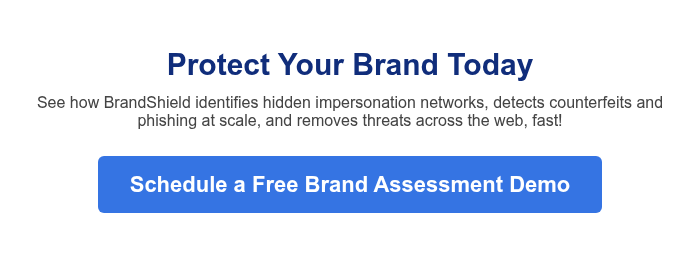The 10 Most Common Online Marketplace Scams and How to Protect Your Brand
Online marketplaces have revolutionized how people shop. With a few clicks, anyone can list a product, find a buyer, or reach millions of customers around the world.
Platforms such as Amazon, eBay, Alibaba, and Facebook Marketplace have made eCommerce more accessible than ever. However, this convenience has also created a global opportunity for scammers.
Fraudsters have turned online marketplaces into a breeding ground for fake listings, counterfeit products, and brand impersonations. According to the Global Anti-Scam Alliance, online scams cost the world more than one trillion dollars between 2023 and 2024, with online marketplaces accounting for a significant portion of that loss.
For legitimate companies, the consequences are serious. Counterfeit listings confuse consumers, erode trust, and divert revenue. In this article, we will explore the most common online marketplace scams and show how BrandShield helps businesses detect, analyze, and remove them before they cause your business and customers harm.
The Hidden Risks Behind Online Marketplaces
Online marketplaces are built on convenience and trust. Shoppers assume the listings they see are real, while brands depend on platforms to remove fraudulent sellers quickly. Unfortunately, the reality is far more complex.
Scammers use the openness of these platforms to their advantage. They can create hundreds of fake listings in minutes, impersonate real brands, and use artificial intelligence to generate realistic images or reviews. Because many of these sellers operate under new or anonymous accounts, tracking them manually is almost impossible.
This is where BrandShield’s AI-powered platform makes a difference. By continuously monitoring marketplaces, BrandShield identifies suspicious listings, seller patterns, and counterfeit networks across multiple regions and languages. It then prioritizes and removes the most damaging threats to protect both revenue and reputation.
The 10 Most Common Online Marketplace Scams
Although new schemes appear every year, most marketplace scams follow predictable patterns. Below are ten of the most widespread scams, and how BrandShield helps companies take action with human-verified enforcement.
1. Counterfeit Product Listings
Fake products are the most common type of marketplace scam. Scammers copy brand names, logos, and images to sell counterfeit versions of popular products such as shoes, electronics, and cosmetics.
These counterfeits not only deceive consumers but also damage brand credibility. Customers who receive low-quality or unsafe items often blame the legitimate company, not the scammer.
How BrandShield helps:
BrandShield uses AI-driven image recognition and keyword clustering to detect counterfeit product listings across global marketplaces. Every flagged listing is reviewed by BrandShield’s enforcement team, which includes IP attorneys who verify the violation before initiating takedown procedures through appropriate legal channels.
2. Fake Brand Stores and Impersonation Pages
Scammers frequently create fake storefronts that look identical to official brand shops. They use logos, product images, and marketing text copied from legitimate sites to trick buyers into thinking they are purchasing from a trusted source.
BrandShield’s solution:
BrandShield’s automated monitoring system detects unauthorized storefronts and marketplaces that misuse your trademarks and brand identity. Once flagged, BrandShield’s legal team reviews the evidence and initiates coordinated enforcement actions to shut down impersonation networks through official platform processes.
3. Phishing and Off-Platform Payment Scams
Some scammers lure customers off the marketplace to complete purchases through fake payment links or checkout pages. These sites often mimic marketplace design and feature brand logos to appear credible. Victims who enter their details risk identity theft and financial loss.
BrandShield’s solution:
BrandShield continuously monitors the web for domains, URLs, and social profiles that imitate your brand. Lookalike domains are flagged by the system and reviewed by our legal team, which then coordinates domain-level enforcement and takedown requests through ICANN-accredited registrars or platform abuse channels.
4. Listing Cloning and Bait and Switch
Fraudsters copy genuine product listings, keeping the same descriptions and reviews, but change the payment destination or seller identity. After collecting payment, they either disappear or send low-quality counterfeits instead.
BrandShield’s solution:
BrandShield detects duplicate listings and identifies patterns in pricing, language, and visuals. Our expert enforcement team reviews the findings and prepares takedown submissions backed by documented IP evidence.
5. Deepfake Product Images and AI Reviews
Scammers now use AI-generated photos, videos, and reviews to make fake listings appear legitimate. For example, a counterfeit watch might feature a hyper-realistic product video generated entirely by AI.
BrandShield’s solution:
BrandShield’s visual detection tools flag manipulated images and deepfakes. These are not removed automatically. Instead, our IP legal specialists verify the materials, confirm rights ownership, and initiate enforcement actions in compliance with local IP law.
 6. Fake Shipping, Deposit, or Escrow Services
6. Fake Shipping, Deposit, or Escrow Services
In this scam, buyers are told their payment will be held by a third-party courier or escrow service until the item is delivered. In reality, the so-called escrow service or shipping provider is fake, and the money goes directly to the scammer.
These scams often use well-known brand names or logos to appear trustworthy, sometimes impersonating legitimate retailers or payment partners.
BrandShield’s solution:
While BrandShield does not track logistics providers or verify shipping services, we do monitor for unauthorized use of your brand across websites and marketplaces. If scammers use your company’s name, logo, or visual identity in fake escrow or payment schemes, our platform will detect these impersonations. Every flagged incident is reviewed by our enforcement team, who submit takedown requests for any verified brand abuse.
7. Overpayment and Refund Scams
A buyer sends more than the agreed amount and asks the seller to refund the difference. Once the refund is sent, the original payment is reversed or proven fraudulent.
BrandShield’s solution:
BrandShield identifies suspicious buyer accounts and activity patterns. While AI detects anomalies, our enforcement team investigates further to verify fraudulent intent and ensure that enforcement is aligned with platform policy and legal standards.
8. Unauthorized Resellers and Grey Market Dealers
Unauthorized sellers offer genuine products outside approved channels, often undercutting official pricing. This can lead to warranty issues, brand confusion, and customer dissatisfaction.
BrandShield’s solution:
BrandShield flags unauthorized sellers based on brand guidelines, distribution rights, and geographic restrictions. All enforcement actions are vetted and executed by our IP professionals, ensuring that only verified violations are pursued.
9. Fake Reviews and Manipulated Ratings
Scammers generate fake reviews to boost their product visibility or damage competitors. AI now enables the creation of thousands of fake comments that appear authentic.
BrandShield’s solution:
BrandShield identifies review manipulation linked to scam networks. Detected behavior is cross-checked by our team, who then work with platforms to report abuse and restore accurate product representation.
10. Marketplace Brand Impersonation Networks
Some scams are not isolated. They are part of large-scale networks operating across multiple platforms under different names.
BrandShield’s solution:
BrandShield’s AI.ClusterX™ technology uncovers these connections, but enforcement is never automated. Every cluster is investigated by our enforcement team, and verified networks are dismantled through targeted takedowns executed in line with platform policies and legal procedures.
The Real Cost of Marketplace Scams
Scams on online marketplaces can result in lost revenue, brand dilution, and customer backlash. According to OECD data, counterfeit goods now account for more than 3 percent of global trade. For industries like fashion, beauty, and consumer electronics, the impact is especially severe.
BrandShield’s clients have significantly reduced scam-related incidents by combining AI monitoring with legally sound, human-reviewed enforcement.
How BrandShield Helps Protect Your Brand
BrandShield provides a comprehensive platform for digital brand protection — but enforcement is never left to automation.
Here’s how we work:
- Detection: AI-powered crawlers scan marketplaces, social platforms, and domains for unauthorized use of brand assets.
- Clustering: AI.ClusterX™ links connected threats across platforms to expose larger networks.
- Prioritization: Our system identifies the most urgent threats. But before any action is taken, it is reviewed by BrandShield’s professional enforcement team.
- Takedown: Takedowns are never automatic. Every request is prepared and submitted by our experienced IP lawyers and enforcement professionals, ensuring legal compliance and accuracy.
- Reporting: Clients receive detailed dashboards and enforcement reports that document threats and outcomes with full transparency.
With BrandShield, businesses gain both the speed of AI and the judgment of legal professionals.
Conclusion: Marketplace Scams Require Smart, Human-Led Enforcement
Online scams are becoming more complex, but they can be stopped. BrandShield combines real-time technology with the experience of legal experts to protect your brand where it matters most – across marketplaces, domains, and social platforms.
Whether your company faces counterfeit goods, fake stores, or impersonation networks, BrandShield ensures that enforcement is done responsibly, accurately, and in compliance with intellectual property law. Schedule a demo to protect your brand.

